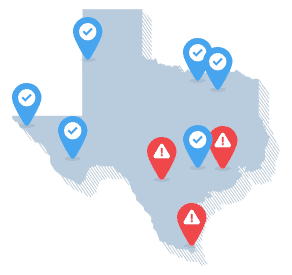The Safest and Most Dangerous Cities in Texas

Texas Security Solutions
The following is a list of cities that provide home security solutions in the state of Texas
Texas is known as the Lone Star State, with big skies, booming cities, and a bold attitude that’s made it an international icon. But, there’s far more than just cacti and cowboys in the nation’s second-largest state. From the rodeos of Houston to Austin's live music scene, the state's diverse culture is reflected in its rapidly growing population, which reached over 31 million by mid-2024.1
Economically, Texas stands as a powerhouse. It boasted a Gross State Product of $2.7 trillion in 2024, driven by key industries such as energy, technology, agriculture, and health care. Much of this economic activity is concentrated in the “Texas Triangle,” a mega-region encompassing Austin, Dallas-Fort Worth, Houston, and San Antonio, home to more than half of the state's population. Beyond its urban centers, Texas offers world-class outdoor destinations, including national parks, beaches, and golf courses.
Crime in Texas Is a Complex Landscape
While everything may be bigger in Texas, the crime rate tells a more complicated story. The state sits above the national average for violent crime and ranks among the top 10 for property crime. However, both of these rates have decreased year-over-year. Still, these numbers aren’t entirely surprising given Texas’s explosive population growth, driven by job opportunities, affordable real estate, and the absence of a state income tax.
Texas cities with the highest and lowest crime rates
(per 100,000 people)
| Cities with the highest property crime rates | |
|---|---|
| South Padre Island | 13,379 |
| Balcones Heights | 10,130 |
| Humble | 9,843 |
| Cities with the highest violent crime rates | |
|---|---|
| South Padre Island | 1,904 |
| Gonzales | 1,706 |
| Balcones Heights | 1,633 |
| Cities with the lowest property crime rates | |
|---|---|
| Collinsville | 48 |
| Friona | 50 |
| Alpine | 51 |
| Cities with the lowest violent crime rates | |
|---|---|
| San Elizario | 10 |
| Fulshear | 16 |
| Parker | 10 |
Note: Excluding cities with crime rates of zero. Source: 2023 FBI Data
High-Crime Cities in Texas
South Padre Island
South Padre Island is a popular Gulf Coast destination known for its miles of sandy beaches, sport fishing opportunities, and laid-back lifestyle. The city of just over 2,000 is also a prime spot for spring breakers looking to start the party every March, or, in some cases, crash it. Unfortunately, the influx of tourists alongside a small year-round population has pushed South Padre Island to the highest property-crime and violent-crime rates in Texas.2
Gonzales
Gonzales is a legendary figure in Texas history. Known as the “Lexington of Texas” after the 1835 “Come and Take It” skirmish, the city was a pivotal outpost during the Texas Revolution in the 1830s. Since then, however, its economy has shifted from agriculture to oilfield services, straining limited police resources and pushing its violent crime rate to nearly four times the national median.3
Balcones Heights
Balcones Heights is a suburb inside the central Texas mecca that is San Antonio. The compact enclave is home to around 2,700 residents and features a tight grid of shops, restaurants, and a renowned hospital. However, the high volume of foot traffic and limited police patrols have led to some of the highest violent and property crime rates in Texas relative to its small year-round population.
Humble
Humble sits just north of Houston in Harris County and is home to just over 16,000 permanent residents. The city originally started off as a boom town when oil was first discovered there in the early 1900s. Since then, industrial corridors, major interstates, and proximity to George Bush Intercontinental Airport have led to high property crime rates.4
Low-Crime Cities in Texas
San Elizario
Located along the Rio Grande in far west Texas, San Elizario is a charming city of just over 10,000 that enjoys a rich history and tight-knit sense of community. While the town’s jail may have been broken into by famous outlaw Billy the Kid in the 1800s, the days of shootouts and showdowns are long gone — the city has the lowest violent crime rate in the state.5
Fulshear
Located on Houston’s western edge, Fulshear is a rapidly growing city that blends upscale suburban charm with a slower pace of life. The town’s rapid growth is a result of numerous master-planned communities and top-rated schools. However, crime has not kept pace with the population, as Fulshear boasts one of the lowest violent crime rates in the state.
Parker
Parker may seem like an unassuming, tranquil suburb just north of Dallas. But, the city of just over 6,000 boasts a legendary secret: Parker is home to Southfork Ranch, known to many as the Ewing family’s home in the hit television series Dallas. While the show may have featured crime and deceit, the real-life location could not be further from that: Parker boasts one of the lowest violent crime rates in Texas.
Collinsville
Collinsville is a quaint, small Texas town north of DFW with a population of just over 1,800 residents. Its small size helps the city boast one of the lowest property crime rates in both the state and country. Collinsville is known for its award-winning school district and proximity to outdoor attractions like Lake Ray Hubbard.6
Friona
Nestled in the Texas panhandle, Friona is known as “The Biggest Small Town in Texas.” The city of 4,000 boasts a steadily growing population and economy, combined with a vibrant local retail community. While outdoor attractions and the Parmer Medical Center certainly bring residents in, the low property crime rates are a big factor in determining why they stay.7
Alpine
Alpine serves as one of Texas’s best-kept secrets. The mountain town is located in the heart of the Big Bend Region, surrounded by rugged West Texas peaks and valleys. The rich cultural scene features multiple museums and Sul Ross State University. The city of approximately 6,000 blends small-town charm and easy outdoor access, leading to one of the lowest property crime rates.
Crime Trends in the Lone Star State
Texas has a crime rate that sits above the national average, ranking 17th for violent crime and 9th for property crime. Aggravated assault is the most common crime in Texas, followed by larceny theft. The state is an economic and population powerhouse, so growing pains are to be expected within a region so large and diverse.
Texas is positioned more moderately in crime rates compared to its neighboring states. It experiences lower violent crime rates than New Mexico, Louisiana, and Arkansas, though its rate is slightly higher than Oklahoma's. In terms of property crime, Texas's rate is lower than those of New Mexico and Louisiana but higher than Oklahoma's.
Violent crime rates
(per 100,000 residents)
| Category | Texas | National |
|---|---|---|
| Murder | 6.0 | 5.7 |
| Aggravated assault | 281.7 | 263.7 |
| Robbery | 68.8 | 65.4 |
| Rape | 49.5 | 38.0 |
Texas’s violent crime is 12 percent above the national average, with 406 crimes per 100,000 people. However, there was a 6 percent decrease in the violent crime rate from 2022 to 2023. Texas’s murder rate outpaced the nation by 5.3 percent.
Property crime rates
(per 100,000 residents)
| Category | Texas | National |
|---|---|---|
| Burglary | 303.9 | 250.7 |
| Larceny | 1,524.5 | 1,343.9 |
| Vehicle theft | 409.9 | 317.2 |
The state’s property crime rate is 17 percent above the national average. However, it is decreasing as well, with a 2.7 percent drop from 2022 to 2023. All types of property crime — including burglary, larceny theft, and vehicle theft — are well above national averages.
Where Our Crime Data Comes From
Unless specified otherwise, the information in this article is based on crime data compiled by the FBI and made available through the Crime Data Explorer. Statewide violent and property crime statistics are drawn from the FBI’s 2023 Crime in the United States Report (Table 5), while metro area data comes from Table 6, which breaks down offenses by metropolitan statistical areas. For city-level crime rates, we referred to Table 8, which lists reported offenses by state and city.
Important Note: Crime statistics offer valuable insights, but they aren’t the only way to evaluate a community’s safety. Local context, law enforcement practices, and reporting standards can all influence how crime is recorded. Additionally, FBI publication tables and the data displayed on the Crime Data Explorer may differ slightly due to variations in methodology.
Navigate Crime Data by State
- Alabama
- Alaska
- Arizona
- Arkansas
- California
- Colorado
- Connecticut
- Delaware
- Florida
- Georgia
- Hawaii
- Idaho
- Illinois
- Indiana
- Iowa
- Kansas
- Kentucky
- Louisiana
- Maine
- Maryland
- Massachusetts
- Michigan
- Minnesota
- Mississippi
- Missouri
- Montana
- Nebraska
- Nevada
- New Hampshire
- New Jersey
- New Mexico
- New York
- North Carolina
- North Dakota
- Ohio
- Oklahoma
- Oregon
- Pennsylvania
- Rhode Island
- South Carolina
- South Dakota
- Tennessee
- Utah
- Vermont
- Virginia
- Washington
- West Virginia
- Wisconsin
- Wyoming
References
- ValleyCentral. SPI considered 2nd most violent city in Texas — here’s why locals and visitors don’t believe it.
https://www.valleycentral.com/news/local-news/spi-considered-2nd-most-violent-city-in-texas-heres-why-locals-and-visitors-dont-believe-it/ - Texas State Historical Association. Gonzales, TX.
https://www.tshaonline.org/handbook/entries/gonzales-tx - City of Humble, TX. Humble History.
https://www.cityofhumbletx.gov/humble-history/ - Visit El Paso. San Elizario Jail and Billy the Kid Jail.
https://visitelpaso.com/places/san-elizario-jail-and-billy-the-kid-jail#:~:text=Things%20To%20Do&text=1500%20Main%20St.&text=Dating%20back%20to%20the%201800's,on%20let%20me%20Instagram%20this.%E2%80%9D - Southfork Ranch. Southfork Ranch
https://southforkranch.com/ - Friona Chamber of Commerce. More Than Just a Small Town.
https://www.friona-chamber.com/more-than-just-a-small-town - U.S. Bureau of Economic Analysis. (2024, Mar 29). Gross Domestic Product by State and Personal Income by State, 4th Quarter 2023 and Preliminary 2023.
https://www.bea.gov/sites/default/files/2024-03/stgdppi4q23-a2023.pdf
